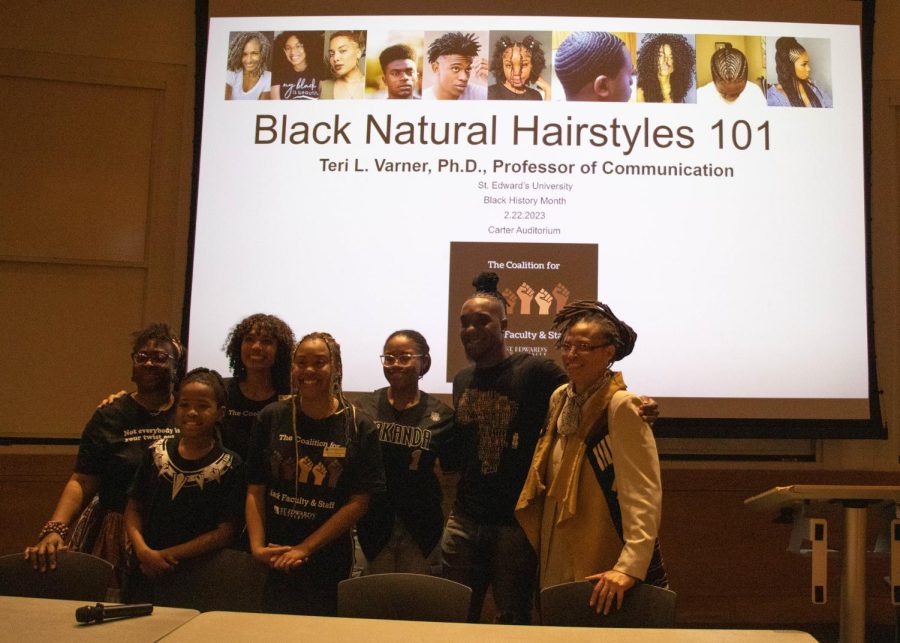Communication professor leads discussion tackling cultural appropriation, modification of the BIPOC community
In the Carter Auditorium on Feb. 22, Professor of Communication and member of The Coalition for Black Faculty and Staff, Dr. Teri Varner, held a presentation and discussion on Black Hairstyles & Cultural Appropriation. This event was sponsored by the Coalition of Black Faculty and Staff here on campus to celebrate Black History Month.
Many students, alumni, faculty, family and friends attended this event. They participated in a Q&A session that was led by a group of panel members: Aneasha Lawrence, assistant director of admission and co-chair of the Coalition for Black Faculty & Staff; Gwen Schuler ‘94, Director of Communications and Co-Chair of The Coalition for Black Faculty & Staff; Brieanna Bowman ‘19, assistant director of alumni relations and licensed cosmetologist; Wanye’ Tate, assistant director of Student Involvement; Calen Kelly, a senior and current President of the Black Student Alliance at her highschool The Ann Richards School for Young Women Leaders; and her younger brother Andrew.
Lawrence started the event by introducing Dr. Varner, who immediately grabbed the audience’s attention by singing, “Cottonballs, cotton balls, that’s what they used to call me…”, a poem by Tanisa Jeffers that discusses the common texture of a Black person’s hair and the anger and frustrations that come along when someone asks a Black person the rude question: can I touch your hair?
Dr. Varner explained how in the 1960s and 1970s, many African-American females continued to participate in changing their hair through chemical and/or heated processes. This is an example of assimilation when a minority group or culture resembles the values, beliefs and behaviors of the society’s majority group. This also shows the lengths many Black women feel they need to go to to be successful.
“According to The Crown Coalition in partnership with Dove, a Black woman is 80% more likely to change her natural hair to meet social norms or expectations at work,” Dr. Varner said. “And these women are 50% more likely to be sent home or known of a Black woman sent home from the workplace because of her hair.”
“Identity politics is something we should all be paying attention to,” Dr. Varner continued. “Whether we recognize it or not, we often make unconscious choices and assumptions about who gets to do what, when, why or where and more specifically who gets promoted or hired.”
Dr. Varner goes into the topic of Black hairstyles, along with photos of their style accompanied by its traditional meaning, description and even the products used to create the hairstyle. Next, she went into the definition of cultural appropriation and showed some examples of statements made by famous people, such as writers, speakers and former wearers of locks. Feminista Jones and what was said in her Dear White People with Dreadlocks comment. She goes on to explain the definition of Cultural Appropriation, Cultural Appreciation, Cultural Assimilation, and Cultural Exchange and explains the main difference between appropriation and appreciation, which she says is power, “Cultural appropriation is about the power dynamic.”
Before the panelists were introduced and the Q&A session began with the audience, Dr. Varner talked about several other topics, such as the reasons why cultural appropriation feeds racism, the price of having Black hair in a White world and ways to avoid cultural appropriation by asking yourself is the cultural group that you are borrowing from considered the minority or oppressed group?
The panelist led a discussion with the audience by answering and asking several questions. For example, is it true that Black people’s hair doesn’t grow? And is it true that people with locs/locks/dreads don’t wash their hair? And of course, most of these assumptions are myths, a majority, if not all, human hair grows, and yes, people with dreads do wash, and they actually do so frequently.
“All of these things will stick with me, all educational conversations,” Lilly Dazet, an attendee who works in the admissions office, said. “You can never know too much, and I want to sit in all the rooms and learn all of the things.”
“My main takeaway from this event was that everyone’s experience as a Black person is different with their hair, but the commonalities that we have, the care and the process, this familiarity can be found with everybody,” Kelly said. “Just have those conversations with other people, and keep everyone informed in this day and age where things are getting better but they could always be improved.“
This event was one of many that our university and the people within our community made possible in celebration of Black History Month.







